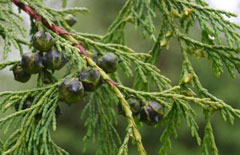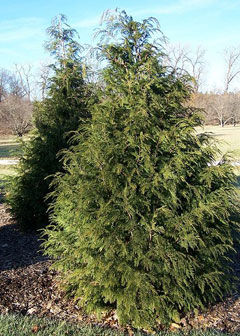 |
|
http://en.wikipedia.org/wiki/User:MPF |
 |
| http://commons.wikimedia.org/wiki/User:Bruce_Marlin |
Translate this page:
Summary
Main Bloom Time: Early spring, Late spring, Mid spring. Form: Columnar, Pyramidal.
Physical Characteristics

 Chamaecyparis nootkatensis is an evergreen Tree growing to 15 m (49ft) by 6 m (19ft) at a medium rate.
Chamaecyparis nootkatensis is an evergreen Tree growing to 15 m (49ft) by 6 m (19ft) at a medium rate.
See above for USDA hardiness. It is hardy to UK zone 5. It is in leaf all year, in flower from March to April, and the seeds ripen from October to November. The species is monoecious (individual flowers are either male or female, but both sexes can be found on the same plant) and is pollinated by Wind.
It is noted for attracting wildlife.
Suitable for: light (sandy), medium (loamy) and heavy (clay) soils, prefers well-drained soil and can grow in heavy clay soil. Suitable pH: mildly acid, neutral and basic (mildly alkaline) soils and can grow in very alkaline soils.
It can grow in semi-shade (light woodland) or no shade. It prefers dry or moist soil. The plant can tolerates strong winds but not maritime exposure.
It cannot tolerate atmospheric pollution.
UK Hardiness Map
US Hardiness Map
Synonyms
Cupressus nootkatensis. Thuyopsis borealis.
Plant Habitats
Woodland Garden Canopy; Hedge;
Edible Uses
References More on Edible Uses
Medicinal Uses
Plants For A Future can not take any responsibility for any adverse effects from the use of plants. Always seek advice from a professional before using a plant medicinally.
Antirheumatic Miscellany Poultice Skin
The plant has been used in sweat baths for treating rheumatism and arthritis[257]. An infusion of the branch tips has been used as a wash for sores and swellings[257]. A poultice of the crushed leaves has been applied to sores[257]. The soft bark has been used as a cover for poultices[257].
References More on Medicinal Uses
The Bookshop: Edible Plant Books
Our Latest books on Perennial Plants For Food Forests and Permaculture Gardens in paperback or digital formats.

Edible Tropical Plants
Food Forest Plants for Hotter Conditions: 250+ Plants For Tropical Food Forests & Permaculture Gardens.
More

Edible Temperate Plants
Plants for Your Food Forest: 500 Plants for Temperate Food Forests & Permaculture Gardens.
More

More Books
PFAF have eight books available in paperback and digital formats. Browse the shop for more information.
Shop Now
Other Uses
Fibre Hedge Hedge Miscellany Tinder Wood
Plants can be grown as a tall hedge[200] They are very tolerant of clipping so long as this does not extend into the brown barked wood since trees cannot regenerate from this[200]. Any trimming should be done in the summer[200]. The fibre of the inner bark is fine and soft, it is pounded and spun then used for making blankets, clothing, capes, mats etc[99, 226, 257]. Torn into pieces, it can be used as bandages or for washing babies[226]. The finely shredded inner bark can be used as a tinder[257]. Wood - hard, very durable, fragrant with an agreeable resinous odour, close grained, has low-shrinkage, is somewhat brittle, but does not splinter. Easily worked, it is used for carving, cabinet work, making boats, implements etc[1, 46, 61, 82, 99, 171, 226].
Special Uses
Attracts Wildlife Food Forest Hedge Hedge Scented Plants
References More on Other Uses
Cultivation details
Landscape Uses:Screen. Succeeds in most soils and situations, but prefers a moist deep loamy soil and a sheltered position[1, 11]. Grows well in heavy clay soils. Survives on dry alkaline soils[200]. Does not grow well on peat or shallow chalky soils[11]. Growth of trees is hardly affected by a lack of phosphate in the soil. Plants are moderately shade tolerant, especially when young[81, 200]. Plants are tolerant of atmospheric pollution according to one report[200], whilst another says that they do not do well in a polluted atmosphere[1]. Plants are hardy to about -35c, they also tolerate low summer temperatures[200]. A very polymorphic species, there are many named varieties[200]. This species establishes well and grows fairly quickly when young[11]. Trees can reach 20 metres tall in 35 years but growth slows as the trees get older[185]. It is cultivated as a timber tree in Europe[50]. Trees in the wild can live for 1,000 years or longer[226], one specimen is believed to be 3,500 years old[229]. This longevity is probably due to the presence of toxic chemical compounds from microscopic fungi concentrated in the heartwood[226]. The wood and foliage have an acrid odour[226]. The bruised foliage releases a smell of turpentine[245]. Favoured by many birds for roosting, high cover and especially for nesting, large specimens of this tree help to attract songbirds to the garden[200]. Trees are notably susceptible to honey fungus[200]. Special Features:North American native, Inconspicuous flowers or blooms.
References Carbon Farming Information and Carbon Sequestration Information
Temperature Converter
Type a value in the Celsius field to convert the value to Fahrenheit:
Fahrenheit:
The PFAF Bookshop
Plants For A Future have a number of books available in paperback and digital form. Book titles include Edible Plants, Edible Perennials, Edible Trees,Edible Shrubs, Woodland Gardening, and Temperate Food Forest Plants. Our new book is Food Forest Plants For Hotter Conditions (Tropical and Sub-Tropical).
Shop Now
Plant Propagation
Seed - sow March/April in a seedbed outdoors[78]. The seed is best sown in pots in a frame[K]. Seed can take 18 months to germinate. One month warm then one month cold stratification has produced good results[113]. When large enough to handle, prick the seedlings out into individual pots and grow them on in a cold frame for their first winter, planting them out in late spring after the last expected frosts. Cuttings in late summer or autumn in sandy soil in a cold frame[1, 11, 200]. Difficult, it may be best done in late winter to early spring[113].
Other Names
If available other names are mentioned here
Native Range
NORTHERN AMERICA: United States (Alaska, Oregon, Washington, California (northwest)), Canada (British Columbia)
Weed Potential
Right plant wrong place. We are currently updating this section.
Please note that a plant may be invasive in one area but may not in your area so it's worth checking.
Conservation Status
IUCN Red List of Threatened Plants Status :

Growth: S = slow M = medium F = fast. Soil: L = light (sandy) M = medium H = heavy (clay). pH: A = acid N = neutral B = basic (alkaline). Shade: F = full shade S = semi-shade N = no shade. Moisture: D = dry M = Moist We = wet Wa = water.
Now available:
Food Forest Plants for Mediterranean Conditions
350+ Perennial Plants For Mediterranean and Drier Food Forests and Permaculture Gardens.
[Paperback and eBook]
This is the third in Plants For A Future's series of plant guides for food forests tailored to
specific climate zones. Following volumes on temperate and tropical ecosystems, this book focuses
on species suited to Mediterranean conditions—regions with hot, dry summers and cool, wet winters,
often facing the added challenge of climate change.
Read More
Expert comment
Author
(D.Don.)Spach.
Botanical References
1160200
Links / References
For a list of references used on this page please go here
Readers comment
© 2010, Plants For A Future. Plants For A Future is a charitable company limited by guarantee, registered in England and Wales. Charity No. 1057719, Company No. 3204567.